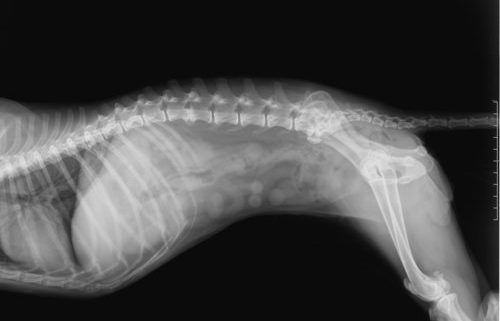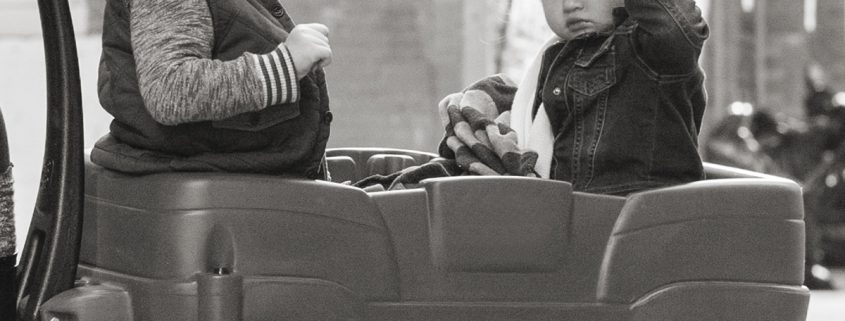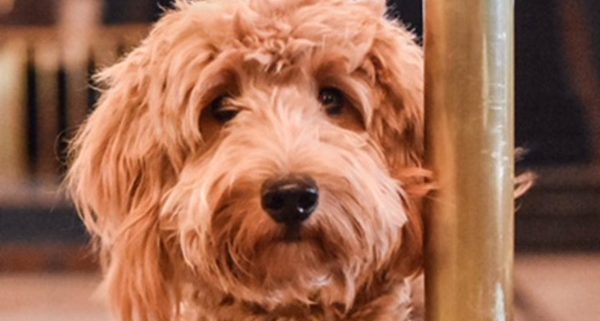Trauma isn’t limited to humans. Whether a result of abuse, abandonment, neglect, an accident or a natural disaster…
Tag Archive for: winter 2017
By MARYSSA BECKMAN, DVM, MECA
The alluring cuteness of Dachshunds and Corgis most likely stems from their disproportionate body composition: long bodies, tiny legs! While absolutely adorable, their layout does not come without added risks. Their tiny spines carry a lot of joint stress that predisposes them to a condition called intervertebral disc disease (IVDD). This disease is common and can result in complete hind end paralysis for life if not recognized and treated quickly. So let’s examine the common signs, why it happens, and what to do if you suspect this disease in your furry friend.
The vertebrae of the spine have small discs between each segment that serve as shock absorbers and keep the vertebrae from suffering trauma when your dog’s body is active. These discs prevent your dog’s spine from being damaged doing simple things like going up stairs or playing catch, but over time these discs undergo degeneration. This results in the hardening of the disc, which ultimately leads to loss of function. When this happens, the disc is at risk of extruding or moving out of its normal position when a compressive force is applied. This is because the normal squishy shock absorber is now a spring-loaded projectile. In small breed dogs, this compacted disc material is extruded upwards when a force is applied to it, and as a result, the spinal cord that lives above it becomes compressed. If this sounds like a bad thing, you’re right! Depending on where this occurs in the spinal cord, signals from the brain may not be able to be transmitted effectively, which can lead to your dog not being able to walk appropriately, control their bladder, and may also cause them a lot of pain. This process can happen in a matter of minutes and will need medical attention fast.
Okay, so I have a large-breed dog. I am safe, right?
Unfortunately, they get their own type of IVDD. Breeds like German Shepherds, Labradors, Dobermans, and really any larger dog that is active can have this occur. The good news is that these types of dogs get a protrusion of the disc instead of an extrusion that comes on slow and can usually be medically managed.
All right, it’s happened! Now how do I treat it?
As you can imagine, nerves are very delicate and require fast action to ensure appropriate recovery. IVDD can range from a small amount of spinal pain to complete hind limb paralysis, and it can progress to an irreversible disease in a matter of hours depending on severity. If your dog is lucky, a small amount of back pain that is often recognizable by your dog crying out going up stairs, reluctance to jump may be as far as it progresses. In this case, strict cage rest and some anti-inflammatory medications can have your pooch back to normal in no time. If, however, your dog is one that has problems placing their feet, cannot stand up, and does not seem to have voluntary bladder control, you may be looking at a surgery to fix your pet. During this surgery, the veterinarian will go into the spine and remove the disc material compressing the spinal cord. This is a costly surgery, and only certain veterinarians will be able to preform it. Before doing so, the exact location of the disc rupture will need to be determined by using X-rays, CT, or potentially an MRI. Once performed, the recovery period is variable with some dogs walking in days, while some may need rehabilitation and may not walk normally for months. Recovery rate is about 70 to 100 percent with dogs that don’t have complete loss of deep pain in their hind limbs before the surgery. If this procedure is not performed quickly, the nerves will lose blood supply and the situation may be irreparable. So if you suspect this is happening to your pet, act fast.
So what signs can you look for, and how can you prevent this?
Dogs usually show a wobbly hind end, reluctance to climb stairs, or may cry out in pain with early onset of the disease. With more progressive disease, dogs will be unable to rise or stand on their own and will be incapable of placing their feet, especially in the hind limbs. Preventing high-impact activity such as jumping, quick turns, or fast stops can limit stress put on the spine. Ultimately though, this can happen to any breed at any time, so knowing what to look for and when to seek veterinary care can save your pet’s life.
By MEGAN TREMELLING, DVM, LVS
Like most veterinarians, I genuinely love animals, but the sad fact is that not all of my patients love me back. For every pet that greets me with a wagging tail and happy kisses, I get at least one who gives me side-eye and a stony expression. I can’t blame them, of course. I invade the personal space of every one of my patients when I do a physical exam, and further indignities and discomforts come with almost everything I do. Some patients take it all cheerfully, others tolerate it, and then there are those who put a furry foot down and say, “No way.”
This is where muzzles come in. Some dog owners find muzzles scary. They can look like torture devices, although they don’t actually hurt the dog, and it is possible to buy cute ones. Dogs dislike the muzzle, and owners find this upsetting. “Why do you need to muzzle my dog?” they sometimes ask. “He’s not going to bite you! What kind of veterinarian is afraid of dogs?”
Well, it’s like this. I’m not afraid of dogs; if I were, I couldn’t do my job. I do, however, have a certain respect for what their teeth can do. It’s born of seeing many a dog bite injury in my career: many of them on my patients, some on my co-workers, and a few on myself. Our furry best friends come with teeth that were designed to cut and crush flesh, and they’re pretty good at it. Big dogs of course can be more dangerous, but size doesn’t always matter. Almost any dog can, if motivated, give me an injury that will put me out of work for months.
What are the odds that any particular dog will bite? Unfortunately, that dog’s owner isn’t always the best person to make that prediction. Dogs that are angels at home with their people sometimes make bad choices when they’re in a strange place, surrounded by strangers, feeling threatened, or cornered or in pain. Some dogs will even bite their owners when they’re at the vet’s office. In this game, there are no bonus points for doing things the reckless way so I prefer to err on the side of safety.
Placing a muzzle on an uncooperative dog can actually make the process of providing veterinary care easier on the patient. It isn’t immediately obvious that this would be true, but it is true. Some dogs, when muzzled, just freeze. You have seen this phenomenon in action if you have ever seen a rowdy puppy annoying an older dog until the adult has to give the pup a correction; they do this by taking hold of the pup’s muzzle to make it stop misbehaving. In the same way, some dogs, when muzzled, seem to get the message that it’s time to stop snapping and struggling. That means I can do my job quickly and thoroughly rather than having a prolonged wrestling match that’s far more upsetting to the patient than whatever it was I was trying to do in the first place. Of course, the process works best if the dog is muzzle-trained, and I encourage every dog owner to do so.
But even or especially in patients that won’t give up resisting, a muzzle ultimately reduces the risk of anyone getting bitten. And while I selfishly want to keep my skin intact, I also want to avoid bites for the dog’s and the owner’s sake. Wisconsin state law is quite strict on the subject of dog bites. Any medical care provider who treats a person that was bitten by a dog is legally required to report the bite to the authorities, and the dog is then subject to rabies quarantine. This is expensive for the dog’s owner and means extra visits to the veterinarian’s office for the dog that didn’t enjoy going in the first place. If the dog dies or is euthanized for any reason before the end of the quarantine period, its body must be tested for rabies, a process that can also be expensive for the owner.
Of course muzzles aren’t the only tool I have to keep teeth off skin. I rely on my expert staff to distract and safely restrain pets, and I use all my training and experience to make veterinary care as painless and reassuring as possible for the patients. But there are times when a muzzle is the right choice, and then I don’t hesitate. It’s for everybody’s protection.
BY STACY KRAFCZYK
Animals are like us in so many ways that sometimes we forget or don’t realize that what we do for ourselves we can also do for them. For instance your dog may benefit from the following: massages, chiropractic, acupuncture, crystals, hydrotherapy, laser therapy, Reiki and more.
Animal communication is a great “tool” to use to find out if your animal is happy, sad, in pain, etc. But it’s also important to use other tools. It is necessary to take your animals to the vet for health checks and various treatments. Or for example, dog trainers for proper training. And it is also important to see practitioners who specialize in holistic animal care—Chinese and western medicines are a great combination.
For example, if your animal doesn’t feel well, is lethargic or not eating and looks like it is suffering, then a vet would be your first call. Your second call should perhaps be an animal communicator.
Animal communication can definitely improve behavioral issues, walking on a leash, and other issues. However, training is still necessary to build ones confidence with their dog so they learn to speak the same language and not send mixed messages. As humans we tend to send mixed messages to our animals, telepathically and verbally. In our minds we say, “don’t bite, don’t bark, don’t jump” but in our minds we’re showing them barking, biting and jumping. Training is a great way to send the right signals, deepening the bond and strengthening our confidence.
A few tools:
Chiropractic/Spinal Manipulation. Animals get thrown out of whack all the time, just like humans do, and strongly benefit from adjustments to realign their body which also affects their health, energy and emotions.
Essential Oils. Get ones that are all-natural (not chemical or fragrance grade) and good quality to diffuse in your room or car, especially after a stressful event like surgery. This can aid in calming your furry friend.
Massage. Getting your animal massaged will keep your animals limber, energetic and bring relief especially if there is already an issue at hand.
Reiki. A form of energy work done in person or from a distance can help heal the animal emotionally, mentally, physically and spiritually. Reiki has been an amazing part of my healing journey personally and professionally with hundreds of animals.
Food. Raw food, high-quality canned or dry food, grain-free, etc., can also assist your animals in healing and reducing ear infections, UTIs, yeast, diabetes and other illnesses or diseases. I’ve personally witnessed miraculous transformations with changing of the diet alone. Contact your local pet food store for holistic options.
Cold Laser Therapy. This is done by certified professionals to accelerate healing safely and effectively.
Pain Medicine. Whether it is holistic, natural, Chinese herbs and/or western meds…it is VERY important to help maintain your animal’s pain in old age, as well as his diseases or illnesses. One of the main complaints from animals is their pain level. Remember, it is an animal’s instinct and nature to hide or disguise his pain. If they were in the wild, they may be killed or forced out of their pack so they tend to hide their discomfort until it becomes so unbearable they begin to show signs like not eating, limping, excessive licking or sudden behavioral changes like aggressiveness, not sleeping well, pacing and digging at the carpet. Please talk to your vet about pain medicine and/or natural remedies from holistic pet food stores.
Sleep. This is important to people for recharging and healing their bodies and is the same for animals. It is challenging for animals to heal and recharge if they’re in pain. A lot of animals have shared in animal communication sessions that they would like some pain management around breakfast, dinner and most importantly, bedtime. Our animal friends will sleep better and so will their humans.
There are many avenues you can explore to help heal your animals emotionally and physically. You may need to use several different healing modalities continually until the pain begins to diminish or is at least under control.
Talk to your vet about some of these options and if your vet doesn’t know about these, then do your own research. Go in chat rooms, Facebook groups, and on other websites to find the right answers for your animals. The Internet is awesome for finding out information.
Dear FETCH Friends:
Since my kids were born, I have been told that they will be alright as long as they are loved! And as a mom of two kids with autism spectrum disorder, my automatic response inside my head is, “yeah right.” It takes so much more than just loving them to help them succeed. They need therapy, special toys, extra socialization, more routine and structure, etc. Most of all they need a strong and functional mom and dad. There are so many days I just get down on myself wondering what I did wrong. Because yes, I am that powerful to have caused this right? Ehh, wrong!
But aside from all the self-pity and isolation one may feel at times, isn’t the bottom line for getting them all of this “extra stuff” they need, love? Yes, it is! Love and support.
As long as most of us receive an adequate amount of love, recognition and support in our daily lives, we will continue to persevere throughout the day. Just knowing we are good at our jobs (even if we don’t like them) can be enough for us to show up. However, to perform above and beyond our own expectations, we need to know others appreciate us as well. We need continued support and recognition to really conquer the unexpected.
Regardless of my childrens’ disabilities, they will flourish in life. Why? Because God and other caring individuals (dogs especially) will help them in their darkest of times.
The way my son lights up when he is around our rescue pittie Sophia is just heartwarming. He always makes sure to hug and kiss her goodbye before going to school in the morning. And for that minute, he is present and experiencing joy.
Life is so unexpected. And appreciating those that love and support you in the toughest of times is incredibly important. We need others. We need our canine companions.
To exceeding beyond your own limitations,
What do service dogs, therapy dogs and emotional support dogs all have in common besides being…well…dogs?
By MANETTE KOHLER, DVM
Word is out around Milwaukee. There’s a cute new gal with blonde, curly hair working at the Hilton Milwaukee City Center. It’s Millie, the canine concierge. At just one year of age, Millie, a mini Goldendoodle, is very popular and regularly receives emails and comments via the hotel website, great Trip Advisor reviews, and dog treats, sweaters and toys from adoring fans (aka hotel guests). Her proud owner, Rusty Dahler, the human concierge at the hotel, was thrilled to share Millie’s story with FETCH readers.
“Last fall the idea for a ‘hotel dog’ began to circulate,” says Dahler. “A great idea never happens easily,” he adds. “It takes a lot of determination and hard work.” He set to work finding just the right dog for the job, researching breeds and talking to breeders and decided on a smaller, non-shedding dog with a phenomenal temperament. Millie, whose name represents Milwaukee (first and third syllables), fit the bill perfectly. Born September 13, 2016, Millie went home with Dahler at eight weeks of age and by ten weeks was spending a few hours at a time at the hotel. She now spends 40 hours a week in the lobby and hotel, brightening the day for guests and employees alike.
As one would guess, training has been and continues to be a focal point for Millie. Dahler explains that it’s been a lot of work to train a puppy in such a large hotel and to teach her all the things she’ll need to learn including not jumping on guests and coming when called. Holly Lewis, a Certified Professional Dog Trainer and owner of Cold Nose Canine, has worked one-on-one with Millie as well as in group classes. “Millie’s private lessons are focused on specific skills that Millie utilizes at the hotel,” says Lewis. “Millie learned to stay out of specific areas of the hotel as well as showing guests where the restroom is from the concierge desk.” The “say hello” cue directs Millie to the check-in line where she greets guests. She may even bring along her favorite ball for someone to throw.
Other important tasks include riding luggage carts up to the rooms for deliveries and standing proudly on the podium at the front door, smiling and wagging her tail as guests arrive. “On the flip side,” adds Lewis, “it is really important for her to remain in tune with Rusty so she does not wander off and get distracted with a guest. Recall and focus are important points of Millie’s training.” The need to be able to easily adapt to the fast pace and changing environment of the hotel lobby is the biggest goal, according to Lewis. “There are always people and animals breezing through the lobby and it takes a special dog to be able to handle the activity,” says Lewis.
“Millie has changed the environment in our lobby by 100 percent,” shares Dahler. He knew she’d have an impact on the guests, but he never guessed the impact she’d have on the employees. They stop by the desk to share phone pics of their dogs and love on Millie as if she were their own. Fellow co-worker, bellman Jack Wood says, “Being able to experience Millie’s friendly and playful personality is the reason both myself and the guests keep coming back to see her every day.” Millie takes all the attention from guests and employees in stride, and that’s part of what makes her so special. “She gives a lot to her work,” says Dahler. She’s petted hundreds of times per day, often awakening from a nap because an eager guest really wants to say hello.
Like any hard working employee, Millie deserves and enjoys her time off. “Home is her restful space where she can do what she wants to do when she wants to do it,” says Dahler. “She enjoys walks on Brady Street, playing with dog friends at Pulaski Park and dog training classes at Cold Nose Canine,” he adds. She also enjoys the company of Oliver and Rose, Dahler’s two cats. “Oliver and Millie love to hang out and tussle together while Rose enters in only when she thinks it appropriate.” As for toy preferences, the more squeakers the better, but long toys she can play tug with are also preferred.
Dahler explains how rewarding it’s been to see her progress and to hear guests comment on how well-behaved she is. “She has brought smiles, laughter, and even tears to many within her short time here and we can’t wait for more of this to come as she grows older with the Hilton Milwaukee,” shares Dahler.
For more info check out “Millie At The Hilton” on YouTube; on Instagram at “hiltonmilwaukee” and on Facebook at Hilton Milwaukee City Center.

For Book, Product & Article Review:
Email us for further instructions.
FOR DIRECT QUESTIONS:
Nastassia Putz, Publisher
(262) 337-1967
nputzfetchmag@gmail.com
FOR ADS/DISTRIBUTION:
Current Circulation: 10,000 to 13,000 copies per quarter, distributed to 300+ locations throughout Southeastern Wisconsin (Milwaukee, Madison, Racine/Kenosha, Green Bay).
Questions? Email us at info@fetchmag.com.





